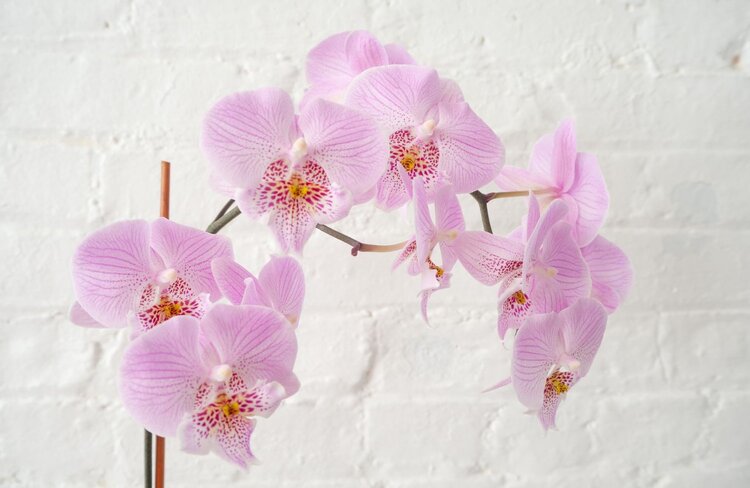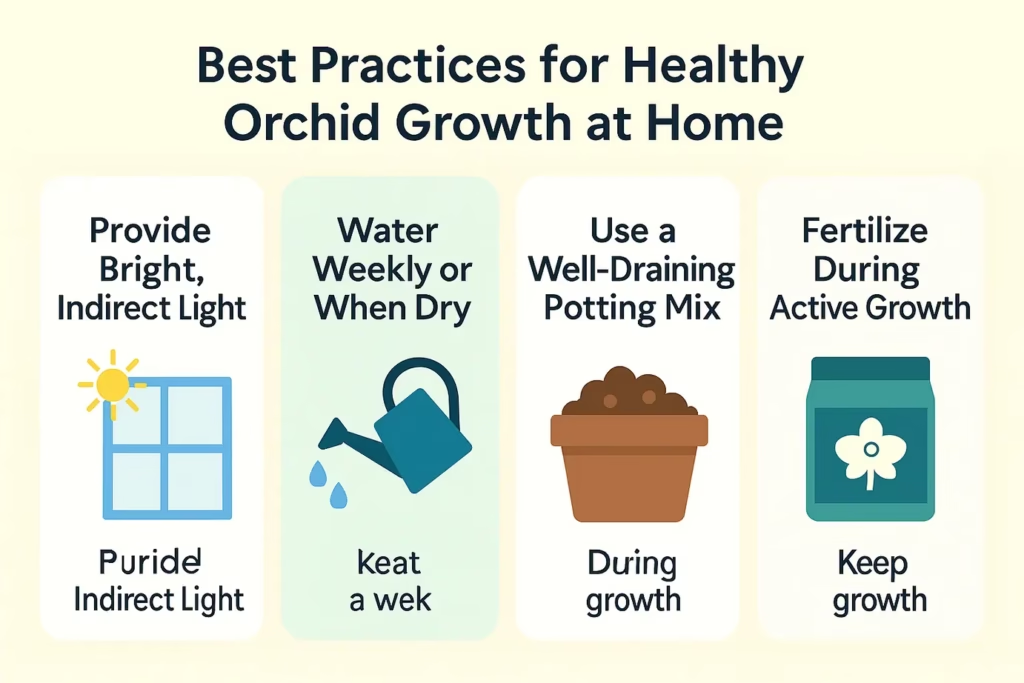A common headache among orchid lovers is, ‘Why is my orchid stem turning pink?’ Well, orchid stems may turn pink due to factors like natural pigmentation, sunburn, or light stress from excessive direct sunlight, environmental stress, nutrient deficiency, and physical damage like cuts.
Identifying the cause will help address the issue effectively. If you want to find out more, we have discussed elaborately below.
What Does a Pink Orchid Stem Indicate?
Orchid stem color can offer insights into health, but interpretations vary by species. Pink or greenish-pink indicates robust growth with proper care. Pigmentation is natural in some species.
Unexpected pink may signal stress due to environmental changes or light issues, requiring adjustments. Sunburn from excessive direct sunlight can cause pink hues. Nutrient deficiency may manifest as a pink stem with poor growth.
Pink stems with wilting, yellowing, or spots might indicate infection, warranting investigation and action. Observe your orchid closely, adjust its environment if needed, and seek expert advice if problems persist. Prioritize your orchid’s well-being for thriving blooms.
Do you know about some effective alternatives to Physan 20? If not, please check this comprehensive guide on helpful Physan 20 alternatives.
What Are the Reasons Orchid Stems Turning Pink?
Orchid stems can turn pink for various reasons, and the cause can vary depending on the specific species of orchid and its growing conditions. Here are some common reasons why orchid stems may turn pink:
Natural Pigmentation
Some orchid species naturally have pink, purple, or reddish stems as part of their normal pigmentation. In such cases, the pink color is a natural characteristic of the plant and does not indicate any health issues.
Sunburn or Light Stress
Orchids are sensitive to direct sunlight, and exposure to intense sunlight can lead to sunburn on their stems and leaves. Sunburn may cause the stems to develop pink or reddish spots or discoloration.
Environmental Stress
Changes in environmental conditions, like temperature fluctuations, sudden changes in light exposure, or extreme humidity levels, can stress orchids, leading to changes in stem color, including pink tints.
Nutrient Deficiency
A lack of essential nutrients can result in abnormal growth and pigmentation changes or even orchid dead stems. If an orchid is not receiving adequate nutrients, it may develop pink hues.
Overwatering or Poor Drainage
Orchids are susceptible to root rot when overwatered or when the potting medium doesn’t allow for proper drainage. Root damage can affect the health of the stem and may lead to pink discoloration.
According to Orchid Resource Center, ‘Overwatering’ is one of the main causes of orchid stems turning pink:
Overwatering, a common mistake that many orchid owners make, can lead to various issues with the plant, including a pink stem. When orchids receive too much water, their roots become saturated and can’t access enough oxygen. This lack of oxygen hampers their ability to absorb nutrients properly.
Physical Damage
Physical injuries to the stem, such as cuts or bruises, can cause changes in color as the plant tries to heal itself.
Genetic Factors
Some hybrids or cultivars may display unique stem colors due to genetic influences.
It’s crucial to note that not all cases of orchid stem turning pink indicate a problem. In some instances, it may be a natural occurrence or a reaction to minor environmental changes.
However, if you see your orchid stem turning yellow and flowers falling off, it can be accompanied by other symptoms like wilting, yellowing leaves, or signs of disease, it may be an indicator of an underlying issue that needs to be addressed.
Check the growing environment, ensure proper watering practices, and provide the orchid with appropriate light and temperature conditions. If problems persist or worsen, consider consulting with a local orchid expert or a horticulturist for further diagnosis and guidance.
What to Do When The Stems of the Orchid Turns Pink?
If you notice your orchid stem turning pink, it’s essential to take appropriate action to identify and address the underlying cause. Here are the steps you can take when the stems of your orchid turn pink:
Inspect the Orchid
Carefully examine the entire orchid plant, including the leaves, roots, and flowers, to check for any other signs of distress or disease. Look for wilting leaves, yellowing, spots, or other unusual symptoms that might provide additional clues.
Check Growing Conditions
Review the growing conditions of your orchid. Ensure that it is receiving the right amount of light, humidity, and temperature suitable for its species. Orchids generally prefer bright, indirect light, well-ventilated environments, and consistent temperature and humidity levels.
Adjust Light Exposure
If the orchid has been exposed to direct sunlight and you suspect sunburn or light stress as the cause of the pink stems, move the plant to a location with filtered or indirect light. This will help prevent further damage.
Check Watering Practices
Orchids prefer a well-draining growing medium and should not be left sitting in standing water. Make sure you are watering the orchid appropriately based on its specific needs. Overwatering can lead to root rot and subsequent stem discoloration.
Assess Potting Medium
If your orchid is potted, check the potting medium. Ensure that it is not breaking down or retaining too much moisture, as this can lead to root issues. Repot the orchid if necessary, using a fresh, well-draining orchid-specific potting mix.
Fertilize if Needed
If you suspect a nutrient deficiency might be the cause of the pink stems, consider fertilizing the orchid. Use a balanced orchid fertilizer at half the recommended strength, and apply it during the active growing season.
Isolate and Treat
If you observe any signs of disease or infection, such as fungal spots or lesions on the stems, promptly isolate the affected plant to prevent the spread to other orchids. You can try using appropriate fungicides or treatments recommended for orchids to address the issue.
Seek Expert Advice
If you are unsure about the cause of the pink stems or if the plant’s condition does not improve despite your efforts, consider seeking advice from a local orchid expert, a horticulturist, or an orchid society. They can provide specific guidance based on their knowledge and experience.
Different orchid species may have different responses to stress or changes in growing conditions. Understanding the specific needs of your orchid will help you better care for it and prevent potential problems in the future.
Best Practices for Healthy Orchid Growth at Home
To prevent issues like pink stems or leaf drop, it’s essential to follow a healthy orchid care routine. Orchids can thrive indoors, but they have specific needs that shouldn’t be overlooked, especially for orchid care beginners.
Start with the right lighting. The ideal light requirements for orchids include bright, indirect sunlight. Avoid direct exposure, which can cause sunburn and discoloration. A spot near an east or north-facing window works well for most types.
When it comes to hydration, learning how to water orchids indoors is key. Water once a week or when the potting mix feels dry. Avoid soaking the roots or letting water sit in the tray, as this can cause root rot and stress.
Use a breathable potting mix like orchid bark or lava rock. These materials promote drainage and airflow, keeping roots healthy.
For lush foliage and blooms, choose the best orchid fertilizer for color and growth. A balanced, water-soluble fertilizer labeled for orchids works well; just use it at half-strength during active growth.
Final Thoughts on Why Orchid Stems Change Color
If you’re asking, why is my orchid stem turning pink or yellow?, the answer could point to natural pigmentation, or it could be a warning sign. Understanding orchid stem turning colors meaning helps you spot trouble early.
Color changes often reflect signs of orchid stress, such as too much direct sunlight, overwatering, or nutrient deficiencies. A sudden pink tint could also mean the orchid is reacting to temperature shifts or poor airflow.
Use stem color as a guide alongside other orchid stem health indicators like root condition, leaf firmness, and bloom cycles. These clues help you know how to tell if an orchid is healthy.
If you notice changes, don’t panic. Adjust lighting, cut back on water, and check your potting mix. These tips for reviving stressed orchids often restore plant health with just a few simple steps.
FAQs
Can a pink orchid stem be a natural characteristic?
Yes, some orchid species have pink, purple, or reddish stems as a natural feature. In such cases, the pink color is not a cause for concern, as it is part of the plant’s normal pigmentation and does not indicate any health issues.
Can overwatering cause pink stems in orchids?
Yes, overwatering can lead to root rot, affecting the orchid’s health and causing pink discoloration on the stems. To prevent this, use a well-draining potting medium, water the plant appropriately based on its needs, and avoid leaving it in standing water.
How can I prevent orchid stems from turning pink?
Preventing pink stems involves providing ideal growing conditions, including bright, indirect light, proper humidity levels, and consistent temperatures. Avoid excessive direct sunlight and ensure adequate watering and drainage.
Regularly monitor the plant’s health, re-pot if necessary, and promptly address any signs of stress. If you have time, please check how Lava rocks help your orchid.








